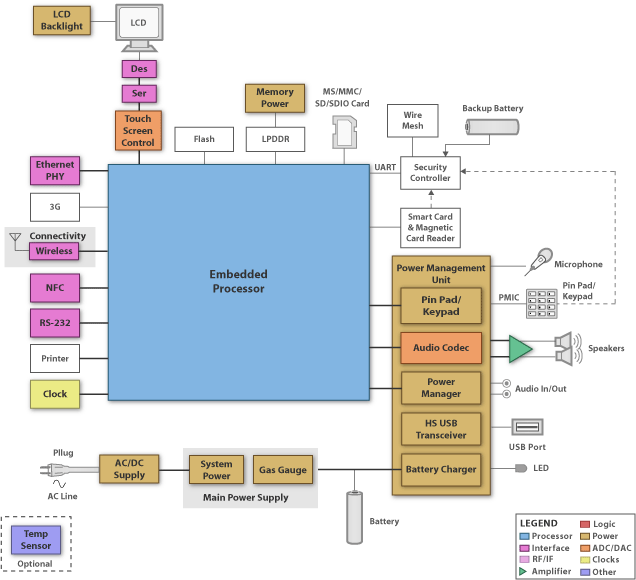
Design Considerations
Electronic Point of Sale (POS) equipment includes products used in the electronic processing of financial transactions in the retail, hospitality and banking segments. Different products in the POS space are card payment terminals, electronic cash registers, self-service kiosks, vending machines and accessories like card readers, pin entry devices and printers.
The key feature of a POS terminal revolves around the reading of contact and contactless cards while securely transmitting the information – including the transaction – to a server for authentication and approval. Today, most POS systems transmit transactions to their network over a tethered connection but there is a growing demand for a portable / mobile solution. TI has a broad array of products and support to help you design your portable point of sale solution.
The core system includes:
• Processor – The Sitara ARM processor is based on the (up to) 1GHz ARM Cortex-A8 CPU and POWERVR SGX™ Graphics Accelerator. This best-in-class ARM and graphics architecture is integrated into the 45nm process technology and is optimized for performance while delivering low-power consumption. The balance of performance and power make this device ideal for Point of Sale equipment.
• Security Technology – Point of Sale systems access and transmit sensitive payment card and encryption key data which needs to be protected at all times, and may need to meet the PCI, or EMV, security standards. These data security standards mandate the need for secure-boot and high-strength encryption based on standards like AES, 3DES, PKA and RSA, among others. TI Sitara products have these features built in to ensure safe and secure operation of your POS system.
• Payment Card Interface: All POS solutions require the ability to read/write data from magnetic stripe cards, smart and contactless cards. Near Field Communication (NFC) based contactless cards becoming more prevalent and the ability to support them is very important. TI has a series of components like data converters, low power RF, RFID and NFC chipsets that will allow for the integration of such card readers in your product.
• Touch Screen Interface – Requirement for touch screen control allows for POS ease-of-use in the field. This feature is enabled on-chip on some of the Sitara processors or available via external touch screen controllers from the TSC series of products.
• Network Interface – The key advantage of a POS is full duplex wireless communication with remote servers and data storage facilities. Most systems require IEEE 802.11abgn wireless LAN as well 2G/3G/4G cellular modems to allow for true mobility. The high performance WL1271 Transceiver chip offers 2.4GHz IEEE 802.11 b/g/n and Bluetooth v2.1 + Enhanced Data Rate (EDR) transceivers. The WL1271 also provides best-in-class coexistence capabilities coupled with TI’s Enhanced Low Power (ELP) technology – helping customers reduce development time, lower manufacturing costs, and ease certification.
• Power Management – TI has a wide range of power management IC's from discrete LDOs to highly-integrated PMIC's (Power Management Integrated Circuits). These PMIC's provide the POS with a solution to generate and regulate core, memory and IO power. They also provide an efficient, eco-friendly power solution for touch screen controllers, key pad interfaces, and USB transceivers.
Click here for user's guide
Download Full Block Diagram Below
Advertisement

Learn more about Texas Instruments





